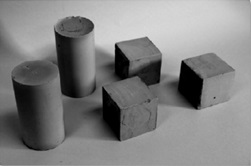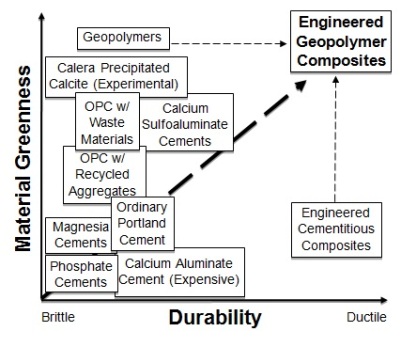|
|
| |
| Development and Characterization of Durable Geopolymer Composites for Truly
Sustainable Infrastructure Applications (NSF Grant Number: 1068005) |
| |
Motivation |
|
Goal & Approach |
|
Results so far |
|
|
| Infrastructure sustainability is a global concern today. Global cement consumption is continuously growing, and the trend seems to continue as emerging countries develop their infrastructure systems. It is known that cement production is one of the world’s most energy and carbon intensive industries, and in fact, it accounts for 5 -8 % of total man-made carbon dioxide (CO2) emissions [1]. Therefore, eco-friendly construction materials are an important key for sustainability. On the other hand, developed countries are facing the aging infrastructure problem. ASCE estimates that $3.6 trillion would be needed by 2020 for repair and maintenance of deteriorated infrastructures [2]. Another key is therefore enhanced durability for less frequent repair and longer service life. We believe that true infrastructure sustainability requires both construction material greenness and enhanced structural durability. |
| |
 |
From the material greenness perspective, geopolymer has been drawing attention as a promising alternative to Ordinary Portland Cement (OPC). Geopolymer is a class of aluminosilicate-based cementitious materials and relies on no cement. It can be made from industrial byproducts such as fly ash, activated by alkaline solution. Geopolymer is attractive due to engineering performances such as higher strength and resistance to acid, corrosion, fire/temperature and frost [3], in addition to material greenness. |
| However, geopolymer is inherently brittle similar to conventional cement concrete, so that the excellent properties are often deteriorated by cracks. Cracks are almost inevitable in brittle materials, especially in large-scale field applications. It is therefore natural that geopolymer applications have been limited to niche applications or small scale products so far. |
|
| |
| Our research group has demonstrated that fiber reinforcing can be highly effective in controlling the brittleness of cementitious materials. ECC materials have ultra-high tensile ductility of 3 – 5 %, several hundred times that of normal concrete, and the durability is greatly improved through multiple crack propagation with tightly controlled crack widths. It is considered that the micromechanics-based design developed for ECC can be applied to brittle geopolymer materials for enhancing the durability as in ECC. Therefore, it is hypothesized that combining the ECC micromechanics design basis with geopolymer matrix could lead to green and durable fiber reinforced geopolymer composites. This Engineered Geopolymer Composite (EGC) will be an entirely new material that contributes to truly sustainable infrastructure systems. This research project examines the above hypothesis theoretically and experimentally. |
 |
|
| |
| References
[1] K.L. Scrivener and R.J. Kirkpatrick, "Innovation in use and research on cementitious material", Cement and Concrete Research. 38 (2008) 128-136.
[2] ASCE. www.infrastructurereportcard.org. 2013 [cited 2013 April 29, 2013].
[3] Provis, J. L., and van Deventer, J., "Geopolymers: Structures, processing, properties and industrial applications", Cambridge (UK): Woodhead Publishing, 2009. |
|
|
 |
|






